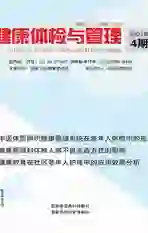异基因造血干细胞移植患者巨细胞病毒感染的临床分析
2021-10-29董瑞红吴秉毅杨辉翟晓熊丹蔡嘉惠
董瑞红 吴秉毅 杨辉 翟晓 熊丹 蔡嘉惠

【摘要】目的:探讨本移植体系下异基因造血干细胞移植患者巨细胞病毒的感染。方法:拟行异基因造血干细胞移植的患者,使用更昔洛韦5mg/kg/次,每日两次,移植前使用2周,至-1d停用,移植后使用阿昔洛韦0.25g 一日两次抗病毒,出院后口服阿昔洛韦1年。分析患者巨细胞病毒感染情况。具体观察指标:移植后半年内巨细胞病毒(CMV)感染率。单因素分析,移植类型或GVHD发生与CMV病毒激活的相关性。结果:分析了22例异基因造血干细胞移植患者,其中全相合移植患者8例,半相合患者14例,移植后半年内CMV病毒阳性率18.2%。结论:移植前病毒清扫,移植后口服抗病毒药物可以有效预防CMV病毒。CMV发生与移植类型、GVHD发生有相关性。
【关键词】异基因造血干细胞移植;CMV感染
Abstract Objective: To investigate the infection of cytomegalovirus in patients undergoing allogeneic hematopoietic stem cell transplantation under this transplantation system. Methods: For patients who are undergoing allogeneic hematopoietic stem cell transplantation, use ganciclovir 5mg/kg/time, twice a day, for 2 weeks before transplantation, stop at -1 day, and use acyclovir 0.25g after transplantation. He was antiviral twice a day and took acyclovir orally for 1 year after being discharged from the hospital. Analyze the patient's cytomegalovirus infection. Specific observation indicators: Cytomegalovirus (CMV) infection rate within six months after transplantation. Univariate analysis shows the correlation between the type of transplantation or the occurrence of GVHD and the activation of CMV. Results: 22 cases of allogeneic hematopoietic stem cell transplantation patients were analyzed, of which 8 were completely matched patients and 14 were halide matched patients. The positive rate of CMV virus was 18.2% within six months after transplantation. Conclusion: Virus cleaning before transplantation and oral antiviral drugs after transplantation can effectively prevent CMV virus. The occurrence of CMV is related to the type of transplantation and the occurrence of GVHD.
异基因造血干细胞移植是根治血液病的一种手段,但移植后的感染、排斥、复发,仍是临床面临的挑战。巨细胞病毒的感染是HSCT后最常见的致死原因之一,尤其是合并CMV肺炎时,死亡率高达80%。因此,CMV病毒的预防至关重要。更昔洛韦是一种广谱抗CMV病毒的药物,在移植前CMV病毒的预防安全性高。我们选取2008年至2020年间行异基因造血干细胞移植患者24例,采用更昔洛韦预防CMV感染,移植后持续1年的抗病毒预防,现将随访情况报告如下。
1.资料和方法
1.1一般资料 2008年6月至2020年 12月在南方医科大学顺德医院进行异基因造血干细胞移植22例,其中男16例,女6例。年齡18~56岁,中位年龄38岁。供受者HLA全相合移植8例,半相合移植14例。
1.2方法
1.2.1CMV预防方案
移植前使用更昔洛韦5mg/(kg.次),一天两次,共使用2周,-1d停用。移植后口服阿昔洛韦0.4g/次,一日三次,口服,至移植后1年。
1.2.2移植预处理方案及GVHD预防方案
全相合患者采用BU/CY方案,半相合患者采用改良BU/POST-CY。GVHD预防采用ATG+环孢素/他克莫司+MTX。
1.2.3移植方式
全相合移植方式为外周血造血干细胞。半相合患者中,急性淋巴细胞白血病患者移植方式为外周血干细胞+脐血,急性髓系白血病患者移植方式为外周血干细胞+NK细胞。
1.2.4移植物抗宿主病(GVHD)发生情况
半相合3例患者出现aGVHD,其中1例急性T淋巴母细胞淋巴瘤,移植后皮肤排斥III°肝脏排斥II°,予2mg/kg甲泼尼龙联合CD25单抗治疗,激素5天后减量,后逐步减停,CD25单抗共用6剂。1例急性淋巴细胞白血病皮肤排斥III°,2mg/kg甲泼尼,CD25单抗使用3剂,后激素逐渐减停。1例骨髓增生异常综合征出仓后出现cGVHD,皮肤排斥II°,口服激素0.5mg/kg控制,后逐步减量小剂量维持。移植后9月复发,输注DLI后出现肠道排斥III°,肝脏排斥II°,使用激素2mg/kg甲泼尼,CD25单抗3剂后控制。
1.2.5CMV监测
粒系重建后,应用RQ-PCR方法监测外周血CMV-DNA,每周1次,至移植后3个月,3个月到半年每2周测一次,6到12个月1个月测一次。
1.2.6CMV的治疗方案
移植后CMV 阳性即启动治疗,使用更昔洛韦 5 mg/ (kg.次),1 次/12 h,诱导治疗2 周,CMV - DNA 转阴后进入维持治疗。维持治疗更昔洛韦 5 mg/ (kg.次),1 次/ d,连用一周。如出现血小板下降,改为膦甲酸钠 60mg/ (kg·d),分 2 次治疗。
1.3统计方法
采用SPSS 22.0统计学软件进行统计学分析。本研究采用Fisher确切概率法分析,卡方值小于0.05无统计学意义。
2.結果
2.1总体CMV感染情况及转归
全相合移植患者无CMV病毒激活。半相合患者中,出现4例血液CMV-DNA阳性,发生率为18.2%(4/22),病毒拷贝数104-105,出现的时间分别为24d、33d、100d、177d,予膦甲酸钠联合巨细胞病毒丙球治疗2例,更昔洛韦治疗2例,其中2例病毒复制下降,1例因早期中枢复发死亡,1例合并重症感染死亡。1例出现巨细胞病毒肺炎,因咯血死亡。1例出现TMA死亡。
2.2CMV感染的单因素分析
采用Fisher确切概率法分析,显示移植后CMV感染与HLA配型不合以及GVHD发生相关,说明HLA配型不合以及GVHD可能激活CMV。见表1。
3.讨论
人巨细胞病毒是一种双链DNA病毒,潜伏于人上皮组织、髓系细胞和T淋巴细胞中,通常在免疫力低下状态下被激活,尤其是异基因造血干细胞移植后,成为异基因造血干细胞移植后常见的病毒感染。临床上可表现为巨细胞病毒血症、巨细胞病毒肠炎、视网膜炎和巨细胞病毒肝炎,导致非复发死亡率升高。目前CMV病毒发生率约10-40%,单倍型移植与脐血移植发生CMV感染率相近。CMV发生与清髓性预处理相关,清髓性化疗导致黏膜受损,免疫系统破坏,免疫重建延迟。同时预防GVHD的方案不同,导致CMV感染率不同。研究发现,预处理时,ATG剂量使用10mg/kg时,CMV病毒激活明显升高。早期急性GVHD也与CMV病毒激活呈正相关,GVHD时激素使用超过1mg/kg/d剂量,病毒激活率明显升高。我们的研究发现,在半相合中CMV发生率明显升高,尤其合并GVHD情况下,激素以及免疫抑制剂的使用激活了CMV病毒。
更昔洛韦仍然是抗CMV病毒的首选药物,它通过抑制病毒DNA聚合酶起作用,最大副作用为骨髓抑制。作为预防和抢先治疗,诱导剂量为5 mg/kg ,每天两次静脉内输注连续 2 周,然后5 mg/kg/d,持续 7-14 天。有研究显示,使用减低剂量的更昔洛韦,5 mg/kg/d诱导治疗,与常规剂量相比,CMV清除以及死亡率方面无明显差异。二线的药物有膦甲酸钠以及西多福韦。近年来,供者来源的CMV特异性T细胞治疗越来越受到关注,尤其在巨细胞肺炎等脏器受累的情况,甚至在重症感染的患者提早到一线。
但在重症的CMV感染的病例,无论选择哪种治疗方法,甚至联合抗病毒药物治疗,最终都没有改变治疗结局。因此,探讨CMV的预防策略是有意义的,寻找 CMV高危因素,进行危险度分层,从预防、抢先治疗等阶段,降低低中危CMV感染发生率,降低高位CMV感染死亡率是目前研究进展。
本中心移植体系下GVHD发生率低,CMV感染相应发生率低,如何在预处理中平衡GVHD和复发,始终是研究学者需要探索的问题。由于本研究病例数有限,研究结果尚需要扩大病例数来验证。
参考文献:
1. Pérez-Romero P, Blanco P, Giménez E, etal. An up-date on the management and prevention of cytomegalovirus infection following allogeneic hematopoietic stem cell transplantation.Future Virol. 2015;10(2):113-134.
2. Camargo JF, Komanduri KV. Emerging concepts in cytomegalovirus infection following hematopoietic stem cell transplantation. Hematol Oncol StemCell Ther. 2017;10(4):233-238.
3. Raiola AM, Dominietto A, di Grazia C, et al. Unmanipulatedhaploidentical transplants compared with other alternative donorsand matched sibling grafts. Biol Blood Marrow Transplant 2014;20: 1573–79.
4. Marty FM, Bryar J, Browne SK, et al. Sirolimus-basedgraft-versus-host disease prophylaxis protects againstcytomegalovirus reactivation after allogeneic hematopoietic stemcell transplantation: a cohort analysis. Blood 2007; 110: 490–500.
5. Giménez E, Torres I, Albert E, etal. Cytomegalovirus (CMV) infection and risk of mortality in allogeneichematopoietic stem cell transplantation (Allo-HSCT): A systematic review, meta-analysis, and meta-regression analysis. Am J Transplant. 2019Sep;19(9):2479-2494.
6. Maffini E, Giaccone L, Festuccia M, etal. Treatmentof CMV infection after allogeneic hematopoietic stem cell transplantation.Expert Rev Hematol. 2016 Jun;9(6):585-96.
7. El Helou G, Razonable RR. Safety considerations with current and emergingantiviral therapies for cytomegalovirus infection in transplantation. ExpertOpin Drug Saf. 2019 Nov;18(11):1017-1030.
8. Hakki M. Moving Past Ganciclovir and Foscarnet: Advances in CMV Therapy. CurrHematol Malig Rep. 2020 Apr;15(2):90-102.
9. Chen K, Cheng MP, Hammond SP, etal. Antiviral prophylaxis forcytomegalovirus infection in allogeneic hematopoietic cell transplantation.Blood Adv. 2018 Aug 28;2(16):2159-2175.
